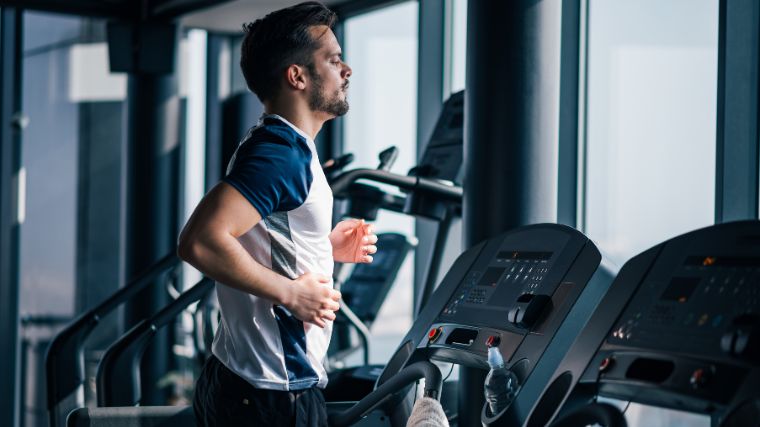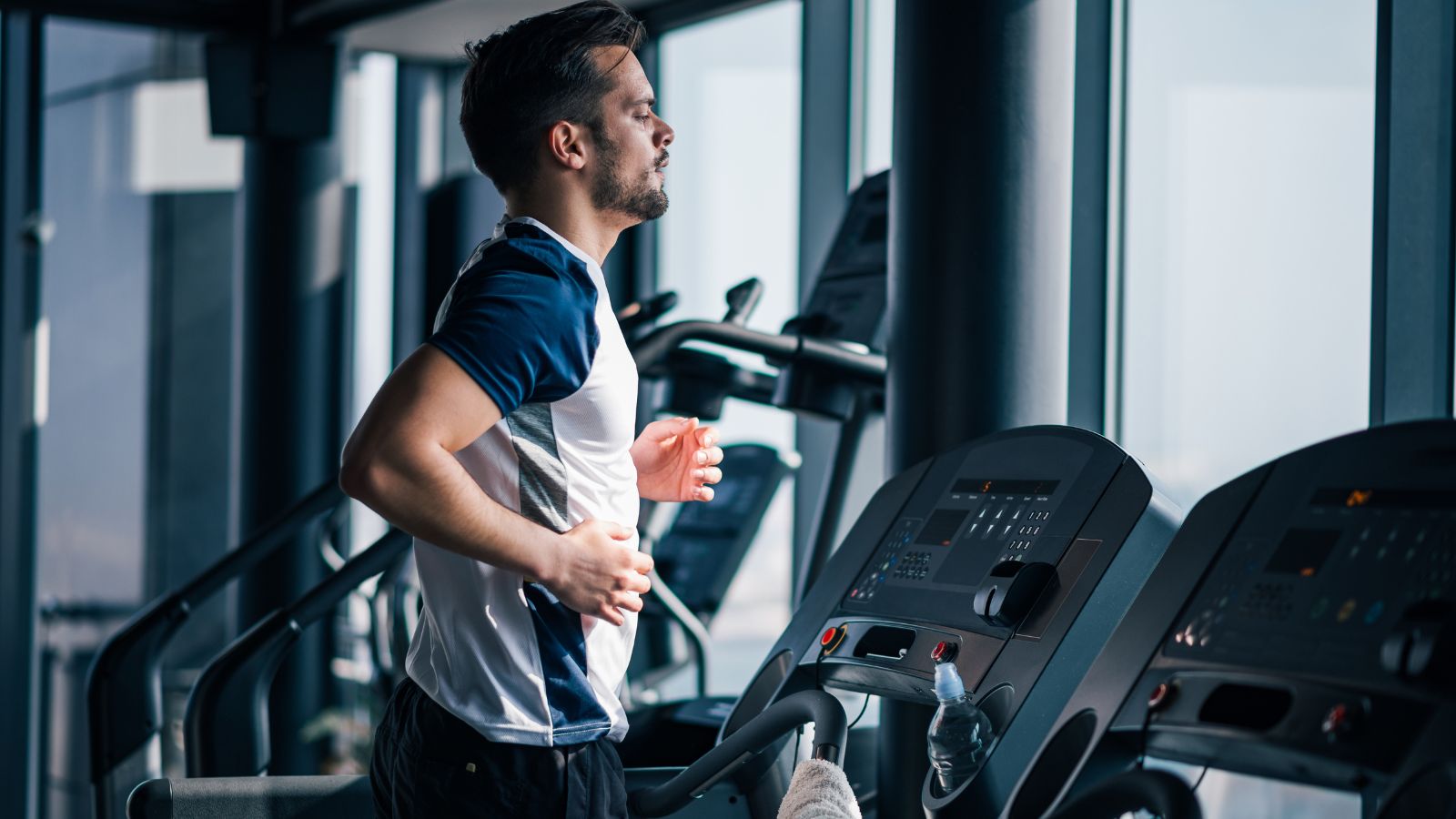If you’re into weight lifting, cardio might not be your favorite day, and you may wonder if it’s necessary. You’re already getting a ton of health benefits from resistance training as you work towards building muscle and strength. Cardio exercise will tax your full body differently from lifting and place more emphasis on your heart.
Cardiovascular exercise has been shown to lower your risk of heart disease as it has a huge impact on your metabolic and immune systems, which deal with your blood flow, blood pressure, and blood sugar. (1) Cardio also benefits your mental and brain health, and improves your sleep quality. (2) All of these components are also key to your lifting journey.

Cardio is also simply another way to get more movement in your life. Being sedentary is a leading cause of health issues, and while you may already be crushing it in the gym a few times a week, even adding a few steady-state walks can be beneficial. (3)
Let’s dive into the specific benefits of cardio and bust some myths along the way.
Editor’s Note: The content on BarBend is meant to be informative in nature, but it should not be taken as medical advice. When starting a new training regimen and/or diet, it is always a good idea to consult with a trusted medical professional. We are not a medical resource. The opinions and articles on this site are not intended for use as diagnosis, prevention, and/or treatment of health problems. They are not substitutes for consulting a qualified medical professional.
What Is Cardio?
Cardio refers to cardiovascular exercise, which is generally aerobic exercise. The American College of Sports Medicine (ACSM) defines aerobic exercise as exercise that uses large muscle groups, is performed rhythmically, and can be sustained for some time. It also should raise your heart rate and increase your breathing. (4)
Aerobic vs. Anaerobic
Aerobic exercise also refers to how oxygen is used in your body. During aerobic or cardio exercise, your cardiorespiratory system delivers oxygen to your muscles to create energy from glucose. During anaerobic exercise like strength training, your body uses stored energy in your muscles (ATP) and does not rely on oxygen being delivered for energy. (4)
How Much Cardio Do I Need?
The physical activity guidelines for Americans from The US Department of Health and Human Services state that the American Heart Association (AHA) recommends adults get 150 to 300 minutes of moderate-intensity aerobic physical activity, 75 to 150 minutes of high-intensity aerobic activity, or a combination of both types per week. (5) The recommendations for regular exercise are to help prevent cardiovascular diseases.
Types of Cardio
As outlined in the American Health Association’s guidelines, cardio exercise can be low-intensity, moderate-intensity, or high-intensity. Steady-state cardio, as defined by the National Academy of Sports Medicine (NASM), is low to moderate-intensity cardio that you can sustain for a long period with your heart rate working at 45 to 65 percent of your max heart rate. (6) Examples include walking or using a low-impact cardio machine where you sustain heart rate for the length of your workout.

(Read More: Nutrition for Athletes — How to Eat for Muscle and Performance)
You can also do bouts of higher-intensity work by putting together exercises into circuits with short rest times — also known as high-intensity interval training (HIIT). HIIT is an efficient way to increase your heart rate faster during a shorter cardio workout. Generally speaking, both steady-state and HIIT workouts can be good for your cardiovascular health, but you should choose based on your fitness level and needs.
Benefits of Cardio
Cardio is an aerobic exercise you can sustain — but why do it? Let’s break down how cardio benefits multiple systems in your body.
Helps Improve Heart Health
Regular cardio exercise is well-known to improve your heart health. It’s long been associated with lowering your risk of heart disease. Just like any other muscle in your body, your heart can undergo hypertrophy. (1)

(Read More: The Best Foods for Energy Before, During, and After Your Workouts)
While doing cardio, your heart rate and your blood pressure temporarily increase. Over time, people adapted to cardio exercise have lower resting heart rates and bigger hearts (literally). (1) By putting yourself under that good stress, you train your heart to withstand exercise and intense activity. Your heart gets stronger and better at pumping blood, so it doesn’t have to work as hard in your everyday life. This physiological response is also how cardio can help lower your risk of a heart attack. (7)
Helps Control Cholesterol Levels
Your cholesterol levels have an impact on your heart health and risk of heart disease as well. First and foremost, it’s important to eat a healthy diet, but regular cardio exercise has also been shown to affect your cholesterol levels.
The American Heart Association states that cardio can reduce your low-density lipoprotein (LDL) cholesterol, also known as “bad” cholesterol, and increase your high-density lipoprotein (HDL) cholesterol or your “good” cholesterol. (8) Too much LDL can put you at risk for atherosclerosis, where your arteries become thickened or hardened. More HDL helps transport the “bad” cholesterol away from your heart. (7)
Helps Strengthen Immune System
Regular physical exercise can help boost your immune system.
Research shows that after less than 60 minutes of moderate cardio exercise, your body can stimulate, activate, and circulate immune cells. (9) By consistently doing cardio exercise and regularly releasing these cells, over time, your immune system becomes stronger, which can help you avoid illness or experience less intense symptoms.
(Read More: Best Treadmills For Streaming, Folding, Running, And More)
Although exercise causes temporary inflammation from oxidative stress, regular exercise is shown to have an anti-inflammatory effect over time, which may be another way that cardio can help give your immune system a boost. (9)
Helps Manage Blood Pressure
It’s well known that regular cardio exercise can lower your blood pressure. Although exercise temporarily increases your blood pressure while you work out, exercise can lower it in the long term and is often recommended for people with hypertension (high blood pressure). (1)
For folks with hypertension, studies show that your blood pressure decreases immediately following exercise and lasts 24 hours. Over time, it may lower as a training response from adapting to regular cardio exercise. (10)
(Read More: 5 At-Home Workouts for Strength, Muscle Growth, Power, and More)
One way this works is that cardio exercise stimulates nitric oxide. Nitric oxide is a gas produced in your body during exercise that helps to widen your blood vessels, improve your blood flow, and lower your blood pressure. (11) You can also increase nitric oxide production in your body by eating nitrate-rich foods or taking supplements that contain nitric oxide boosters.
Helps Regulate Blood Sugar
Studies show that regular physical activity can help control your blood glucose (sugar) levels, improve insulin sensitivity, and play a role in helping prevent type 2 diabetes. (12) Many studies show that people with type two diabetes had improved glucose control and insulin sensitivity following exercise. (1)
The type of exercise matters. Research on whether cardio exercise or resistance training was better for regulating blood sugar levels shows that a combination was more beneficial than on their own. (12) Developing a well-rounded training program with both types of exercise can help prevent or manage type 2 diabetes.
May Help Benefit Mental Health
You may have heard that aerobic exercise gives you endorphins or a “runner’s high” that makes you feel good. This has been referred to as the endorphin hypothesis and has been studied and debated over the years. It actually may be your serotonin levels increasing that make you feel “good” after exercise, but research is ongoing. (13)
Regardless, cardio exercise can have mental health benefits. Aerobic exercise has been shown to reduce symptoms of anxiety and depression. (2) Depression often coexists with other disorders including cardiovascular diseases, and regular exercise may help contribute to the prevention of those conditions as well. (14)
(Read More: Omega 3 Benefits — More Muscle, Better Recovery, and Enhanced Endurance)
One study found that for mild to moderate depression, exercise may have comparable effects to antidepressant medications and therapy. With severe depression, exercise like cardio or strength training may be a helpful addition to other treatments. (15)
May Help Boost Brain Health
Physical exercise has been shown to be beneficial for your brain. It affects your neuroplasticity which can improve your cognitive functioning and general well-being. (16)
Aerobic exercise has been show to potentially be beneficial for people in the early stages of Alzheimer’s disease. Higher cardiorespiratory fitness has been associated with higher brain function, improved memory levels, and less brain atrophy. Regular exercise may also help to prevent dementia. (17)
May Help Improve Sleep Quality
Exercise can help you get better sleep, and better sleep can help you get the most out of your training. A meta-analysis of nine studies on people with insomnia showed that exercise was beneficial in improving sleep quality, but notes that more research is still needed. (18)

(Read More: The 9 Best Ashwagandha Supplements (2023 Update))
Another meta-analysis of sleep studies examined the different effects of acute versus regular exercise on sleep. Acute exercise was found to affect total sleep time, when and how efficiently you fall asleep, and had a small effect on REM (rapid eye movement) sleep. Regular exercise was found to have small-to-moderate benefits on total sleep time, efficiency, and onset; and moderate benefits on overall sleep quality. (19)
May Help Prevent and Manage Osteoporosis
Weight-bearing aerobic exercise — in addition to adequate nutrition and resistance training — is often recommended to people at risk for osteoporosis or those who have been diagnosed with it. (20) Older adults, especially women, are more likely to get osteoporosis as they naturally lose bone density as they age.
Weight-bearing cardio exercise refers to exercise like walking, where you need to support your weight, and not something like swimming or cycling, where you are not. This type of exercise may help strengthen your bones.
(Read More: 7 Tips To Help Keep Your Bones & Joints Strong)
Regular weight-bearing cardio exercise may help to improve bone mineral density (BMD) in postmenopausal women, prevent continued BMD loss in people who already have osteoporosis, and help prevent fractures. (20) For overall bone health, consider combining weight-bearing cardio with resistance training and proper nutrition..
Cardio Benefits for Strength Athletes
Many of the benefits of cardio are helpful to know if you are sedentary or new to exercise. If you already put a lot of time in at the gym doing weightlifting, you’ve gotten your minimum physical activity done, so do you still need cardio?
Weight lifting uses your anaerobic system, and you put in a ton of effort in contracting your muscles for short bursts of highly intense activity. Taking a long steady-state walk is aerobic exercise, and sustaining a moderate heart rate for 30 to 45 minutes will work your body in a different way and provide different benefits.
(Read More: The 15 Best Home Gym Machines)
Walking will put less stress on your body and joints than weightlifting and works great for an active recovery day. Walking 10,000 steps a day has been shown to lower your cortisol and can also help to reduce inflammation in between your strength sessions. (21) Moderate-intensity exercise like walking is beneficial for controlling your cholesterol and blood sugar and reducing your risk of cardiovascular disease. (22) Getting some free, lower-intensity movement, like walking on your off days from training, can also help boost your mental health and focus. (2)
Even though you may spend a lot of time in the gym, you could still be considered sedentary depending on how you spend the majority of your time. Adding in walks helps you move a bit more and gets your blood flowing and heart pumping for a longer period.
Cardio Myths
There are plenty of myths when it comes to cardio exercise — let’s bust a few of them.
Myth: Cardio kills your gains.
When you put in the time, planning, and hard work it takes to build muscle and strength, the last thing you want to do is burn it all away on the treadmill. Cardio doesn’t burn your muscle and kill your gains when done moderately. If you keep your protein high and nutrition on point, doing some low to moderate-intensity cardio, like walking, can be a great addition to your resistance training program. You’ll get the heart benefits without sacrificing your gains.
Myth: Cardio is the only exercise to do for weight loss.
When you’re trying to lose weight, cardio can help you increase your energy output and provide heart and metabolic health benefits. Resistance training builds and maintains muscle mass which has been shown to help you reduce your body fat. (23) A combination of reducing your food intake while keeping protein high, resistance training, and cardio exercise — rather than cardio alone — is an effective and healthy way to lose body fat.
Myth: Runners don’t need to train legs.
It may seem like running is enough of a workout for your legs that you can focus on your upper body when you hit the gym. Running strengthens your legs to an extent, but doing resistance exercises for your lower body is important to build muscle to protect and stabilize your joints.
Potential Drawbacks of Cardio
Too much of anything can be detrimental, and cardio exercise is no exception. Let’s look at a few potential drawbacks.
Cardio Has A Risk of Injury
If you do a lot of high-impact cardio, you run the risk of injury by applying more stress to your joints than they might be used to. Note that HIIT isn’t inherently dangerous as long as you focus on your form, work with reasonable amounts of volume, and don’t push too hard too fast.

(Read More: The 8 Best Knee Sleeves You Can Buy (Spring 2023 Update))
If you’re a strength athlete looking to add cardio to your workout program, doing HIIT in addition to your intense weightlifting may exceed what your soft tissues (think tendons and ligaments) are prepared to tolerate. It’s not bad to add more good stress on your body, but lower to moderate-intensity cardio exercise may help boost your recovery from training without adding more risk.
Cardio Can Get Boring
Let’s face it, a long walk has health benefits but it’s not the most exciting thing in the world. Cardio can get boring, which can make it hard to stick with consistently. Changing up your routine or switching out activities can keep you from getting bored. Listening to podcasts or audiobooks on a walk can also help keep your brain stimulated while you walk.
Too Much Cardio Can Burn Muscle
Doing moderate-intensity cardio while eating enough won’t burn muscle — but too much intensity without enough nutrition and recovery might.
A meta-analysis of studies on cycling and running endurance exercise investigated if either could have a harmful effect on resistance training adaptations. The analysis showed that running in conjunction with resistance training resulted in a decrease in lower-body strength and hypertrophy, while cycling did not. (24)
Live a Long and Sweaty Life
Cardio exercise has many benefits for your physical and mental health. It works your entire body, including some under-trained muscles like your heart and brain. Regular cardio exercise has been shown to help prevent cardiovascular diseases and lower your risk of heart attack or stroke. While it’s important to also eat a healthy diet, cardio helps control your blood sugar and cholesterol levels, helping to prevent or manage type 2 diabetes.
Cardio can impact your cognitive health and improve your bone health which are both important for aging adults. It can help manage symptoms of mental illnesses and boost your sleep quality. It can impact every area of your health, and all it takes is 30 minutes.
Good news, lifters — moderate levels of cardio won’t kill your gains, so grab a quick walk on your active recovery day, soak up some vitamin D, and let out some stress.
FAQs
Got some lingering questions?
What are the benefits of cardio exercise?
Cardio has been scientifically shown to benefit your heart, brain, and bone health, fight and decrease your risk of chronic diseases, and improve your general wellness by managing mental health symptoms and helping you sleep better at night.
What are 10 benefits of cardio?
The top 10 benefits of cardio are improved heart health, controlled cholesterol levels, a strong immune system, healthy blood pressure, controlled blood sugar levels, improved mental health, boosted brain health, better sleep quality, osteoporosis prevention, and active recovery for strength athletes.
How often should you do cardio?
The American Heart Association recommends adults get 150 to 300 minutes of moderate-intensity cardio, 75 to 150 minutes of high-intensity cardio, or a combination of the two types per week. (5) You can split this up throughout the week, depending on what works best for your schedule — but doing more than 30 to 45 minutes at a time isn’t really necessary.
Does cardio help with belly fat?
Cardio, when combined with resistance training and a healthy diet, should help you lose fat overall. That said, “spot reduction” doesn’t exist, and you can’t control where you lose fat.
References
- Nystoriak MA, Bhatnagar A. Cardiovascular Effects and Benefits of Exercise. Front Cardiovasc Med. 2018 Sep 28;5:135.
- Sharma A, Madaan V, Petty FD. Exercise for mental health. Prim Care Companion J Clin Psychiatry. 2006;8(2):106.
- Park JH, Moon JH, Kim HJ, Kong MH, Oh YH. Sedentary Lifestyle: Overview of Updated Evidence of Potential Health Risks. Korean J Fam Med. 2020 Nov;41(6):365-373. doi: 10.4082/kjfm.20.0165. Epub 2020 Nov 19. PMID: 33242381; PMCID: PMC7700832.
- Patel H, Alkhawam H, Madanieh R, Shah N, Kosmas CE, Vittorio TJ. Aerobic vs anaerobic exercise training effects on the cardiovascular system. World J Cardiol. 2017 Feb 26;9(2):134-138.
- Piercy, K. L., & Troiano, R. P. (2018). Physical Activity Guidelines for Americans From the US Department of Health and Human Services. AHA Journal, 11(11).
- Golden, N. What is Steady-State Cardio? NASM.
- Tian D, Meng J. Exercise for Prevention and Relief of Cardiovascular Disease: Prognoses, Mechanisms, and Approaches. Oxid Med Cell Longev. 2019 Apr 9;2019:3756750.
- Myers, J. (2003). Exercise and Cardiovascular Health. AHA Journal, 107(1).
- Nieman DC, Wentz LM. The compelling link between physical activity and the body’s defense system. J Sport Health Sci. 2019 May;8(3):201-217.
- Hegde SM, Solomon SD. Influence of Physical Activity on Hypertension and Cardiac Structure and Function. Curr Hypertens Rep. 2015 Oct;17(10):77.
- Houston M, Hays L. Acute effects of an oral nitric oxide supplement on blood pressure, endothelial function, and vascular compliance in hypertensive patients. J Clin Hypertens (Greenwich). 2014 Jul;16(7):524-9.
- Colberg SR, Sigal RJ, Fernhall B, Regensteiner JG, Blissmer BJ, Rubin RR, Chasan-Taber L, Albright AL, Braun B; American College of Sports Medicine; American Diabetes Association. Exercise and type 2 diabetes: the American College of Sports Medicine and the American Diabetes Association: joint position statement. Diabetes Care. 2010 Dec;33(12):e147-67.
- Heijnen S, Hommel B, Kibele A, Colzato LS. Neuromodulation of Aerobic Exercise-A Review. Front Psychol. 2016 Jan 7;6:1890.
- Murri, M. B. (2019). Physical Exercise in Major Depression: Reducing the Mortality Gap While Improving Clinical Outcomes. Frontiers in Psychiatry, 9.
- Jan Knapen, Davy Vancampfort, Yves Moriën & Yannick Marchal (2015) Exercise therapy improves both mental and physical health in patients with major depression, Disability and Rehabilitation, 37:16, 1490-1495
- Mandolesi L, Polverino A, Montuori S, Foti F, Ferraioli G, Sorrentino P, Sorrentino G. Effects of Physical Exercise on Cognitive Functioning and Wellbeing: Biological and Psychological Benefits. Front Psychol. 2018 Apr 27;9:509.
- Morris JK, Vidoni ED, Johnson DK, Van Sciver A, Mahnken JD, Honea RA, Wilkins HM, Brooks WM, Billinger SA, Swerdlow RH, Burns JM. Aerobic exercise for Alzheimer’s disease: A randomized controlled pilot trial. PLoS One. 2017 Feb 10;12(2):e0170547.
- Banno M, Harada Y, Taniguchi M, Tobita R, Tsujimoto H, Tsujimoto Y, Kataoka Y, Noda A. Exercise can improve sleep quality: a systematic review and meta-analysis. PeerJ. 2018 Jul 11;6:e5172.
- Kredlow MA, Capozzoli MC, Hearon BA, Calkins AW, Otto MW. The effects of physical activity on sleep: a meta-analytic review. J Behav Med. 2015 Jun;38(3):427-49.
- Benedetti MG, Furlini G, Zati A, Letizia Mauro G. The Effectiveness of Physical Exercise on Bone Density in Osteoporotic Patients. Biomed Res Int. 2018 Dec 23;2018:4840531.
- Iwane M, Arita M, Tomimoto S, Satani O, Matsumoto M, Miyashita K, Nishio I. Walking 10,000 steps/day or more reduces blood pressure and sympathetic nerve activity in mild essential hypertension. Hypertens Res. 2000 Nov;23(6):573-80.
- Soroush A, Der Ananian C, Ainsworth BE, Belyea M, Poortvliet E, Swan PD, Walker J, Yngve A. Effects of a 6-Month Walking Study on Blood Pressure and Cardiorespiratory Fitness in U.S. and Swedish Adults: ASUKI Step Study. Asian J Sports Med. 2013 Jun;4(2):114-24.
- Wewege MA, Desai I, Honey C, Coorie B, Jones MD, Clifford BK, Leake HB, Hagstrom AD. The Effect of Resistance Training in Healthy Adults on Body Fat Percentage, Fat Mass and Visceral Fat: A Systematic Review and Meta-Analysis. Sports Med. 2022 Feb;52(2):287-300.
- Wilson JM, Marin PJ, Rhea MR, Wilson SM, Loenneke JP, Anderson JC. Concurrent training: a meta-analysis examining interference of aerobic and resistance exercises. J Strength Cond Res. 2012 Aug;26(8):2293-307.
Featured Image: Branislav Nenin / Shutterstock
10 avantages du cardio – Meilleur sommeil, santé mentale, santé osseuse et plus
L’exercice cardiovasculaire, connu sous le nom de cardio, comprend des activités comme la course, le vélo, la natation et la danse qui augmentent votre fréquence cardiaque et stimulent votre circulation sanguine. Outre les bienfaits évidents sur la perte de poids et la santé cardiaque, le cardio offre de nombreux autres avantages. Découvrez les 10 avantages du cardio les plus importants pour votre bien-être global :
1. Améliore le sommeil
Le cardio régulier est lié à une amélioration de la qualité et de la durée du sommeil. L’activité physique augmente la production de substances chimiques cérébrales qui favorisent le sommeil, ce qui peut aider à lutter contre l’insomnie et favoriser un sommeil profond et réparateur.
2. Favorise la santé mentale
L’exercice cardiovasculaire déclenche la libération d’endorphines, des substances chimiques dans le cerveau qui améliorent l’humeur et réduisent le stress, l’anxiété et la dépression. Une séance d’entraînement cardio régulière peut donc vous aider à vous sentir plus positif et à gérer plus efficacement les facteurs de stress.
3. Renforce la santé osseuse
Le cardio impliquant des activités à impact, telles que la course et le saut, stimule la formation de nouvelles cellules osseuses, renforçant ainsi la structure osseuse et réduisant le risque d’ostéoporose et de fractures.
4. Augmente l’endurance
Le cardio contribue à améliorer votre endurance et votre capacité cardio-respiratoire. En augmentant votre capacité à fournir de l’oxygène à vos muscles, vous pouvez effectuer des activités physiques plus longtemps sans vous fatiguer aussi rapidement.
5. Favorise la perte de poids
L’exercice cardiovasculaire brûle des calories, ce qui peut grandement contribuer à la perte de poids. En intégrant régulièrement des séances de cardio dans votre programme d’exercices, vous pouvez augmenter votre dépense énergétique globale et favoriser le maintien d’un poids santé.
6. Réduit le risque de maladies chroniques
Le cardio régulier aide à réduire le risque de maladies chroniques telles que les maladies cardiaques, le diabète de type 2, l’hypertension artérielle et certains types de cancer. Il améliore également votre profil lipidique en augmentant les niveaux de « bon » cholestérol (HDL) et en diminuant les niveaux de « mauvais » cholestérol (LDL).
7. Booste le système immunitaire
L’activité cardiovasculaire régulière stimule le système immunitaire en augmentant la circulation sanguine et la distribution des globules blancs, ce qui aide à combattre les infections et les maladies.
8. Améliore la santé cardiovasculaire
Le cardio augmente votre fréquence cardiaque, ce qui renforce votre muscle cardiaque et améliore la circulation sanguine générale. En conséquence, il diminue le risque de maladies cardiaques en réduisant l’accumulation de plaque dans les artères et en contrôlant la pression artérielle.
9. Augmente la confiance en soi
Les séances d’entraînement cardio régulières aident à améliorer votre apparence physique et à favoriser une image corporelle positive. L’augmentation de l’estime de soi et de la confiance en soi sont des bénéfices psychologiques importants qui peuvent se traduire par un plus grand succès dans d’autres aspects de votre vie.
10. Favorise la longévité
Plusieurs études ont démontré que la pratique régulière d’exercice cardiovasculaire est associée à une augmentation de l’espérance de vie. En prenant soin de votre santé cardiovasculaire, vous pouvez non seulement vivre plus longtemps, mais aussi profiter d’une meilleure qualité de vie.
FAQ
Le cardio est-il adapté à tout le monde ?
Le cardio est généralement adapté à la plupart des gens, mais il est toujours recommandé de consulter un professionnel de la santé avant de commencer un nouvel exercice physique, en particulier si vous avez des problèmes de santé préexistants.
Combien de temps devrais-je consacrer au cardio chaque semaine ?
Les organismes de santé recommandent généralement au moins 150 minutes d’activité cardio modérée ou 75 minutes d’activité cardio intense par semaine, réparties sur plusieurs jours.
Quels types d’exercices sont considérés comme du cardio ?
Les activités courantes comme la course, la marche rapide, le vélo, la natation, la danse et la corde à sauter sont considérées comme des formes d’exercice cardiovasculaire.
Puis-je combiner le cardio avec d’autres types d’exercice ?
Oui, il est recommandé de combiner le cardio avec des exercices de renforcement musculaire, tels que la musculation, le yoga ou le Pilates, pour obtenir un programme d’entraînement complet et équilibré.
Quand est le meilleur moment pour faire du cardio ?
Le meilleur moment pour faire du cardio est celui qui convient le mieux à votre emploi du temps et à votre rythme de vie. Certains préfèrent le matin pour commencer la journée avec de l’énergie, tandis que d’autres préfèrent l’après-midi ou le soir pour se déstresser après une longue journée de travail.
.

